
Doves are beautiful birds that can bring a sense of peace and tranquility to your garden. But when they start nesting in unwanted areas, they can become a nuisance. The good news is, there are several humane and effective strategies to deter doves from nesting in undesirable locations. This comprehensive guide will walk you through various methods, considerations, and tips to keep your property dove-free.
To deter doves from nesting, you can use bird roosting spikes, foul odors like peppermint oil or cayenne pepper, shiny objects, and sonic or ultrasonic repellent devices. Removing food sources and installing physical barriers like bird netting can also help. Additionally, creating alternative nesting places like birdhouses can encourage doves to nest in more suitable locations. Always remember to check with your local wildlife agency before taking any action to ensure you’re not violating any laws.
Understanding Dove Nesting Habits
Doves choose their nesting sites based on several factors. They prefer areas with abundant food sources, protection from predators, and proximity to roosting and feeding sites. They are highly adaptable and can nest in a wide range of habitats, from coniferous and deciduous trees to shrubs, vines, ledges, and even on the ground. They are also relatively unbothered by human presence and can nest around homes, using gutters, eaves, or abandoned equipment.
Legal Considerations
Before you begin implementing any deterrent strategies, it’s important to be aware of the legal considerations. Many bird species, including doves, are protected under the Migratory Bird Treaty Act (MBTA) in the United States, which makes it illegal to disturb or remove an active nest without a permit. Always check with your local wildlife agency before taking any action to deter or remove nests.
Humane Deterrent Strategies
- Deploy bird roosting spikes: Install these on flat ledges to prevent doves from landing and nesting in these areas.
- Use foul odors: Peppermint oil, cayenne pepper, or garlic spray can deter birds due to their strong smells.
- Hang shiny objects: Aluminum foil, shiny tape, or old CDs can scare away doves.
- Eliminate food sources: Removing bird feeders or fallen fruits can discourage doves from nesting nearby.
- Install physical barriers: Bird netting or bird spikes can block access to nesting areas.
- Create alternative nesting places: Birdhouses or nest boxes in a more suitable location can encourage doves to nest away from undesirable spots.
- Use sonic or ultrasonic repellent devices: These can deter doves from nesting in large outdoor areas or semi-enclosed spaces.
- Trim vegetation: Pruning shrubs, bushes, and trees can make the area less attractive for nesting.
- Use visual deterrents: Predator decoys, such as fake owls or snakes, can scare away doves.
Maintaining Local Biodiversity
While it’s important to deter unwanted nesting, we should also consider the importance of maintaining local biodiversity. Plant native flowers, fruits, and vegetables in your garden to support the local ecosystem and attract a variety of wildlife. Stick to walking paths and avoid disturbing natural habitats when outdoors.
Final Thoughts
Detering doves from nesting doesn’t have to be a daunting task. By understanding their nesting habits, respecting the law, and implementing humane deterrent strategies, you can effectively manage the dove population on your property while promoting local biodiversity. Remember, it’s all about creating a balance between our needs and the needs of our feathered friends.
Frequently Asked Questions
What is the Migratory Bird Treaty Act (MBTA)?
The Migratory Bird Treaty Act (MBTA) is a United States federal law enacted in 1918 to protect migratory birds, their parts, nests, and eggs from hunting, selling, purchasing, or trading without a proper permit.
How do sonic or ultrasonic repellent devices work?
Sonic or ultrasonic repellent devices emit sound frequencies that are uncomfortable or disturbing to birds, thereby deterring them from nesting in the area. The sounds can range from predatory bird calls to high-frequency sounds inaudible to humans.
Can I use any type of shiny object to deter doves?
Yes, you can use any shiny object like aluminum foil, shiny tape, or old CDs. The reflective surfaces of these objects create a visual disturbance that deters doves.
Is it harmful to the doves to use foul odors as a deterrent?
No, using foul odors does not harm doves. It simply makes the area unappealing to them. Always ensure that the substances used are non-toxic and safe for all wildlife.
What should I do if I find an active dove nest in an undesirable location?
If you find an active dove nest, it’s best to leave it undisturbed until the chicks have fledged and left the nest. Disturbing or removing an active nest is illegal under the Migratory Bird Treaty Act (MBTA) without a permit. After the birds have left, you can remove the nest and implement deterrent strategies to prevent future nesting in that location.









